You are using an out of date browser. It may not display this or other websites correctly.
You should upgrade or use an alternative browser.
You should upgrade or use an alternative browser.
Spinel color descriptions
- Thread starter 7188429
- Start date
- Joined
- Nov 16, 2003
- Messages
- 645
- Joined
- Sep 20, 2008
- Messages
- 25,228
"Cobalt" - spinel color is influenced by the chemical presence of cobalt. Generally the stone should be a deep blue color.
"Cobalt blue" - spinel doesn't have cobalt, but the color is reminiscent of those with cobalt.
It is important to note that vendors often use the latter term loosely, and I've seen very greyish spinels called cobalt blue. Not all cobalt spinels are very saturated in deep blue color either.
While Mahenge is a place and many hot pink and red spinels come from there, I've seen peachy and baby pink spinels called Mahenge.
"Cobalt blue" - spinel doesn't have cobalt, but the color is reminiscent of those with cobalt.
It is important to note that vendors often use the latter term loosely, and I've seen very greyish spinels called cobalt blue. Not all cobalt spinels are very saturated in deep blue color either.
While Mahenge is a place and many hot pink and red spinels come from there, I've seen peachy and baby pink spinels called Mahenge.
Barrett
Ideal_Rock
- Joined
- May 26, 2009
- Messages
- 2,218
Jedi is what Vincent P. called the Burmese reds of intense color, then later used on the Vietnamese cobalt bearing ones, I think!
I always likened the use of "mahenge", with those old school pinks and reds, that had the tiny inclusions that scattered the light and made them "soft/glowly" looking. Remember those?
I always likened the use of "mahenge", with those old school pinks and reds, that had the tiny inclusions that scattered the light and made them "soft/glowly" looking. Remember those?
- Joined
- Nov 16, 2003
- Messages
- 645
Correct, "Jedi" is a term Vincent coined to describe highly saturated Burmese red spinel. The saturation is so intense the stones almost appear to vibrate in the light. I have an image of jedi crystals in my new edition, they were much easier to photograph than faceted gems.
Cobalt blue spinels do contain cobalt, but can vary in both hue and saturation. I visited the mines near Loc Yen, North Vietnam in 2015 and I can tell you that many cobalt blues are fairly pale. The image shows a negotiation, buying a crystal specimen in Loc Yen.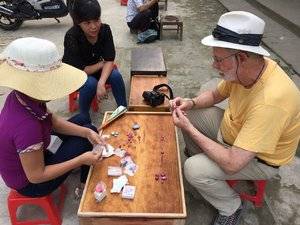
Lighter toned, less saturated large pink spinels have been coming out of East Africa since the early 90s. I was offered eye-flawless stones of up to twenty carats on an early buying trip to Kenya.
Cobalt blue spinels do contain cobalt, but can vary in both hue and saturation. I visited the mines near Loc Yen, North Vietnam in 2015 and I can tell you that many cobalt blues are fairly pale. The image shows a negotiation, buying a crystal specimen in Loc Yen.

Lighter toned, less saturated large pink spinels have been coming out of East Africa since the early 90s. I was offered eye-flawless stones of up to twenty carats on an early buying trip to Kenya.
- Joined
- May 11, 2012
- Messages
- 9,801
The dealers label hot pink spinels from Namya, Man Sin and Burma "Jedi" now as well as the vivid red stones. And at gemshows they tend to label anything neon in a range of pinks and reds from Burma as "Jedi."
Cobalt spinels have cobalt in them they can be a wide range of colours from almost black, electric neon blues, grey blues to very pale blues. They also use the term to describe the top blue spinels from Luc Yen, near Luc Yen and from Africa.
Mahenge spinels come from Mahenge in Africa and seems to be a term that people in the trade tend to use for the more neon stones both reds and top hot pinks (sometimes for lighter pinks too) it is technically the place of origin of the stones but it is also used to describe top or better neon coloured spinels from there.
Flame - orangey red many stones also show brown in some lighting.
I think there are a lot of other descriptions like lilac spinels, purple spinels, grey spinel, silver spinels, titanium spinels etc. They have also started labelling garnets "Mahenge" garnets google it on here to see some pics of them and some of the top pink ones "Lotus" which I maintain is a flashy marketing name for a pink to pinky orange garnet with a distinct chemical composition.
Oooh and I've seen people labelling some spinels "Padparadscha spinels" which IMHO again is just clever marketing of a specific colour....
Cobalt spinels have cobalt in them they can be a wide range of colours from almost black, electric neon blues, grey blues to very pale blues. They also use the term to describe the top blue spinels from Luc Yen, near Luc Yen and from Africa.
Mahenge spinels come from Mahenge in Africa and seems to be a term that people in the trade tend to use for the more neon stones both reds and top hot pinks (sometimes for lighter pinks too) it is technically the place of origin of the stones but it is also used to describe top or better neon coloured spinels from there.
Flame - orangey red many stones also show brown in some lighting.
I think there are a lot of other descriptions like lilac spinels, purple spinels, grey spinel, silver spinels, titanium spinels etc. They have also started labelling garnets "Mahenge" garnets google it on here to see some pics of them and some of the top pink ones "Lotus" which I maintain is a flashy marketing name for a pink to pinky orange garnet with a distinct chemical composition.
Oooh and I've seen people labelling some spinels "Padparadscha spinels" which IMHO again is just clever marketing of a specific colour....
The dealers label hot pink spinels from Namya, Man Sin and Burma "Jedi" now as well as the vivid red stones. And at gemshows they tend to label anything neon in a range of pinks and reds from Burma as "Jedi."
Cobalt spinels have cobalt in them they can be a wide range of colours from almost black, electric neon blues, grey blues to very pale blues. They also use the term to describe the top blue spinels from Luc Yen, near Luc Yen and from Africa.
Mahenge spinels come from Mahenge in Africa and seems to be a term that people in the trade tend to use for the more neon stones both reds and top hot pinks (sometimes for lighter pinks too) it is technically the place of origin of the stones but it is also used to describe top or better neon coloured spinels from there.
Flame - orangey red many stones also show brown in some lighting.
I think there are a lot of other descriptions like lilac spinels, purple spinels, grey spinel, silver spinels, titanium spinels etc. They have also started labelling garnets "Mahenge" garnets google it on here to see some pics of them and some of the top pink ones "Lotus" which I maintain is a flashy marketing name for a pink to pinky orange garnet with a distinct chemical composition.
Oooh and I've seen people labelling some spinels "Padparadscha spinels" which IMHO again is just clever marketing of a specific colour....
Namya is a mining site, (Myanmar) Burma is a country. Did you mean Mogok?
- Joined
- Sep 20, 2008
- Messages
- 25,228
Cobalt blue spinels do contain cobalt, but can vary in both hue and saturation. I visited the mines near Loc Yen, North Vietnam in 2015 and I can tell you that many cobalt blues are fairly pale. The image shows a negotiation, buying a crystal specimen in Loc Yen.
Not true, "cobalt blue" is a term loosely used by many vendors to describe color, but the stones do not have to contain cobalt. "Cobalt spinel" minus the "blue" term must contain cobalt, or it's considered false advertising. Never buy a "cobalt blue" spinel thinking it has cobalt. It is always a good idea to get a lab report backing up any cobalt claims the vendor may have.
- Joined
- Oct 1, 2017
- Messages
- 522
Not true, "cobalt blue" is a term loosely used by many vendors to describe color, but the stones do not have to contain cobalt. "Cobalt spinel" minus the "blue" term must contain cobalt, or it's considered false advertising. Never buy a "cobalt blue" spinel thinking it has cobalt. It is always a good idea to get a lab report backing up any cobalt claims the vendor may have.
100%
Cobalt blue is the same shit like the term Kashmir blue...
Of course there are fine colored blue spinel without a significant cobalt content. Then blue spinel.
But the extremely rare cobalt spinel like this incredible stone from Sri Lanka
https://s3.amazonaws.com/gubelin/spinel-34903.pdf
or the cheaper but also nice cobaltoferrous spinel ( deep to dark blue sometimes slightly grayish ) show the typical natural cobalt spinel spectrum. An iron line around 460 nm and 3 bands from 550 to 670 nm. The higher the cobalt content the stronger ( broader ) they are.
They are responsible for the "red flashed" you see in neon cobalt from Luc Yen or a deep blue from Sri Lanka - cobalt is a very strong coloring agent ( 20 times higher than iron) - course cobalt absorbs the green, yellow and orange part - dispersion is finally violett, blue and red.
I want to see the typical spectrum, red flashes and a pinkish red color using a Chelsea filter. (I check all my cobalts with an UV-VIS-IR spectrometer) .
Vivid to neon to deep blue material from Vietnam is colored by cobalt too with a very low iron content.
Some blue spinel from Tanzania show a nice deep violetish blue - often buyers from Sri Lanka buy them in Africa and cut them in Sri Lanka. To my knowledge the are not colored by divalent cobalt but divalent iron. But show a better color than the grayishblue stones from Sri Lanka.
This is Sri Lanka cobaltoferrous Spinel ( strong spectrum ) compared to a small vivid blue Vietnam cobalt spinel using a 6000 Kelvin lamp ( daylight)
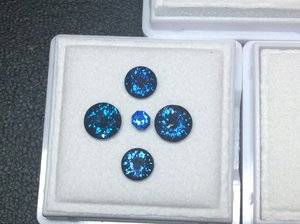
Last edited:
- Joined
- Aug 5, 2010
- Messages
- 12,879
- Joined
- Dec 17, 2016
- Messages
- 1,382
This is perfect! Thank you for sharing the shot of the Luc Yen material compared to the other blue spinels!100%
Cobalt blue is the same shit like the term Kashmir blue...
Of course there are fine colored blue spinel without a significant cobalt content. Then blue spinel.
But the extremely rare cobalt spinel like this incredible stone from Sri Lanka
https://s3.amazonaws.com/gubelin/spinel-34903.pdf
or the cheaper but also nice cobaltoferrous spinel ( deep to dark blue sometimes slightly grayish ) show the typical natural cobalt spinel spectrum. An iron line around 460 nm and 3 bands from 550 to 670 nm. The higher the cobalt content the stronger ( broader ) they are.
They are responsible for the "red flashed" you see in neon cobalt from Luc Yen or a deep blue from Sri Lanka - cobalt is a very strong coloring agent ( 20 times higher than iron) - course cobalt absorbs the green, yellow and orange part - dispersion is finally violett, blue and red.
I want to see the typical spectrum, red flashes and a pinkish red color using a Chelsea filter. (I check all my cobalts with an UV-VIS-IR spectrometer) .
Vivid to neon to deep blue material from Vietnam is colored by cobalt too with a very low iron content.
Some blue spinel from Tanzania show a nice deep violetish blue - often buyers from Sri Lanka buy them in Africa and cut them in Sri Lanka. To my knowledge the are not colored by divalent cobalt but divalent iron. But show a better color than the grayishblue stones from Sri Lanka.
This is Sri Lanka cobaltoferrous Spinel ( strong spectrum ) compared to a small vivid blue Vietnam cobalt spinel using a 6000 Kelvin lamp ( daylight)

- Joined
- May 11, 2012
- Messages
- 9,801
Namya is a mining site, (Myanmar) Burma is a country. Did you mean Mogok?
Namya is a mining site, Man Sin is a mining site, when they find stones from other places in Myanmar (also known in the West as Burma) they refer to them as "Mogok" stones if they are locals and "Burma" stones if they are dealers or at gemshows or talking to confused Westerners, I've seen both locations "Mogok" and "Burma" being used interchangeably to refer to stones from anywhere else. It depends which dealers or sellers you deal with. Usually the main dealers say they from are Man Sin, Namya or Mogok, if you look confused they say Man Sin, Namya and Burma meaning the rest of Burma other than the two main mining areas, at least that has been my experience.
- Joined
- Oct 1, 2017
- Messages
- 522
- Joined
- Aug 5, 2010
- Messages
- 12,879
- Joined
- Oct 1, 2017
- Messages
- 522
- Joined
- Jul 27, 2004
- Messages
- 2,058
T They have also started labelling garnets "Mahenge" garnets google it on here to see some pics of them and some of the top pink ones "Lotus" which I maintain is a flashy marketing name for a pink to pinky orange garnet with a distinct chemical composition.
The Mahenge Garnets are actually called "Mahenge Garnet" because the are found in Mahenge region of Tanzania. They are a very open colored garnet, with colors ranging from a light peach/pink to a purple/red. Many of the garnets from East Africa are a mix and often the location they are found drives the name, such as Umba Garnet and Umbalite Garnet.
- Joined
- May 11, 2012
- Messages
- 9,801
The Mahenge Garnets are actually called "Mahenge Garnet" because the are found in Mahenge region of Tanzania. They are a very open colored garnet, with colors ranging from a light peach/pink to a purple/red. Many of the garnets from East Africa are a mix and often the location they are found drives the name, such as Umba Garnet and Umbalite Garnet.
True, however, the lines of labelling these stones get blurry because Mahenge garnets are also frequently labelled things like Umba Garnets, Umbalite garnets, Almandine Garnets, Rhodolite garnets etc and if you send them to most labs they come back as such not specifically called "Mahenge" garnets, or at least the labs I've had them certified at have never called them "Mahenge garnets" but if that is changing then that is indeed interesting.
- Joined
- Oct 1, 2017
- Messages
- 522
- Joined
- Jul 27, 2004
- Messages
- 2,058
I wouldn't expect a lab to call one of the garnets from Mahenge, a Mahenge garnet. These stones are a mix of Pyrope, Spessartine and Almandine garnets. Samples from the same mine have varied, and varied a lot with the percentages of each.
Not sure why you would send one to a lab, its not like they have any treatments.
There is an interesting book called "Naming Gem Garnets" by Hanneman, it's a bit of a technical read, and seems that there is a lot of disagreement on what garnets should be called, as most stones are not pure pyrope, or Almandine etc, but a mix. Because of this, many have taken to referring to them by the location they are found. Steve, at New Era gems has been obtaining garnets from East Africa for a long time, and many of the popular names are ones he has coined for the stones.
It's not like you are going to walk into a jewelry store and ask to see an Umba garnet or Mahenge garnet. Most jewelers think garnets are dark red, and sapphires are blue. I showed a jeweler a Tsavorite garnet one time and he told me it couldn't be a garnet as it was not red. Tsavorite is of course named after a location, just like the Mahenge garnets. Tsavorite are basically a grossular garnet that is green.
Not sure why you would send one to a lab, its not like they have any treatments.
There is an interesting book called "Naming Gem Garnets" by Hanneman, it's a bit of a technical read, and seems that there is a lot of disagreement on what garnets should be called, as most stones are not pure pyrope, or Almandine etc, but a mix. Because of this, many have taken to referring to them by the location they are found. Steve, at New Era gems has been obtaining garnets from East Africa for a long time, and many of the popular names are ones he has coined for the stones.
It's not like you are going to walk into a jewelry store and ask to see an Umba garnet or Mahenge garnet. Most jewelers think garnets are dark red, and sapphires are blue. I showed a jeweler a Tsavorite garnet one time and he told me it couldn't be a garnet as it was not red. Tsavorite is of course named after a location, just like the Mahenge garnets. Tsavorite are basically a grossular garnet that is green.
Share:
Featured Topics
Past, Present, Future: The Meaning of Three-Stone Engagement Rings
Past, Present, Future: The Meaning of Three-Stone Engagement Rings - 04/14

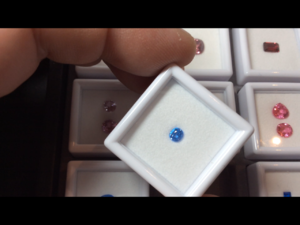
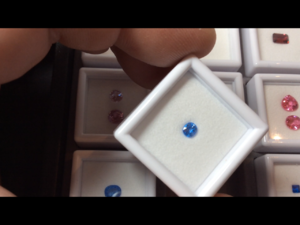
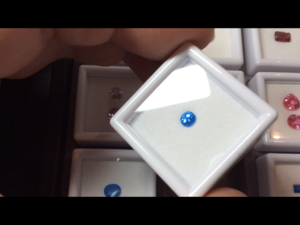


300x240.png)